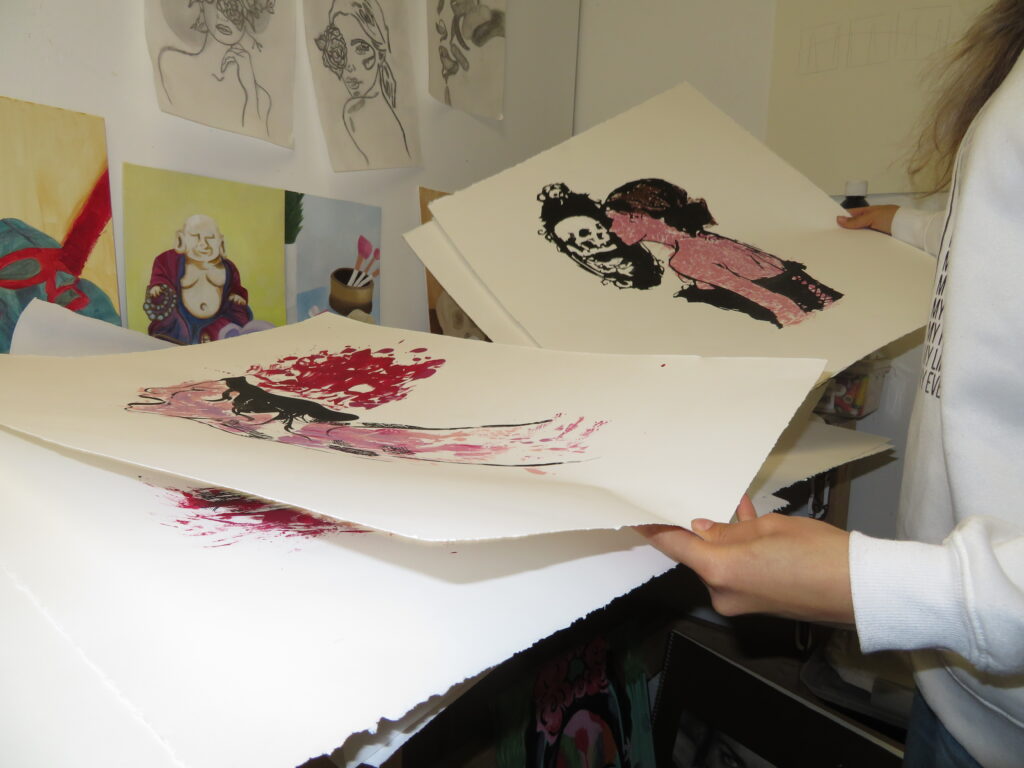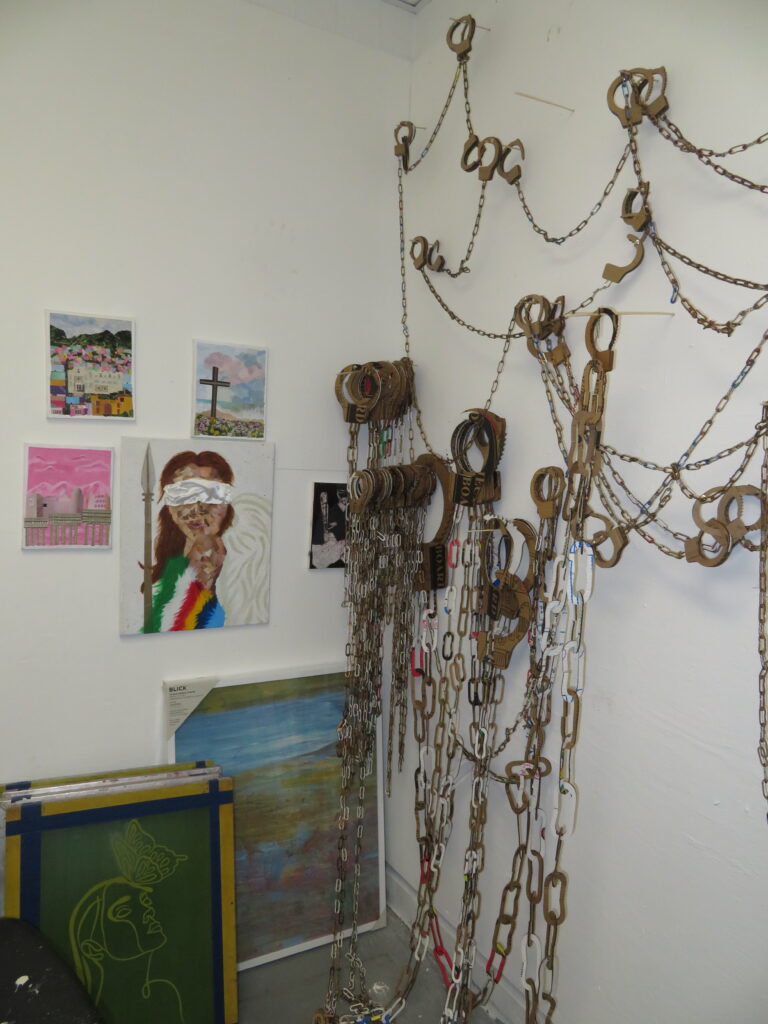
There’s a scar on Anette Ruiz Rojas Monroy’s right hand – slightly above the fold of her wrist, underneath the bone of her thumb. It was from the handcuffs that border patrol officers fastened around her wrists on Feb. 15, 2024. Barely 5 inches around, her wrists slid out from the cuffs by nature of their being, but the officers accused her of attempting to escape. So they tightened them, and the cold metal strangled her wrists. She could feel it cut through the flesh and dig into her bone from behind her back, leaving deep wounds that would remind her of that night.
When Monroy, a fourth-year visual arts major at Point Loma Nazarene University, found out she would have to fill a gallery to fulfill her major and graduate, she had no idea what she was going to make the space about. Her professors suggested that she tap into her roots, as she grew up in Guanajuato, Mexico, and relocated to Tijuana, Mexico, where she lived for 10 years before beginning her studies in the U.S. at Southwestern College. But that wasn’t the story she wanted to tell.
“I’m tired of hearing the ‘I am Mexican and I live in the U.S.’ And, I said – and I remember the words exactly – ‘I need something that is way out of the ordinary that can express a message that goes deep towards the audience,’” Monroy said. “One week after I get arrested, everything happens, and now I have a show. So, be careful what you ask for, just saying, phrase it correctly.”
From the late hours of Feb. 14, 2024, into Feb. 15, Monroy was stopped at the U.S.-Mexico border and detained in U.S. custody for a DUI. She was taken from her vehicle and forced onto the ground by border officers.
That part is clear in her memory.
It becomes blurry in her mind after swallowing the pills that officers made her take at secondary inspection.
“It was a movie on repeat for four, five, six months,” she said. “The first three were pretty rough of every day waking up with those voices in my head with that same picture of me getting to the border, asked by the CBP [Customs and Border Protection] to go to secondary inspection and then it’s blacked out, and spots of it would come back. It was harsh.”
She began to create based upon her experience, slowly working toward exploring what she encountered. In looking back at a series of charcoal sketches she had before the incident, she saw projections of emotions that she would come to experience.
“I look back to those drawings, and I’m like, ‘Oh, I think I did them before it happened,’ without even knowing that it was kind of a projection of my future, like you’re drawing what’s going to happen to you without you knowing it,” she said.
But she had changed from when she first did those sketches, she couldn’t hang the old ones in her gallery. So she took those drawings and transformed them into large screen-printed, monotype portraits depicting a journey through a transformation.

“It’s kind of representing, for me, God tearing myself apart in order for rebirth. So, it’s a base representation of it, starting from the negative to the positive.”
Dave Adey, one of the art professors who has been working with Monroy to bring the show to the walls of Keller Gallery, said that Monroy’s dedication to improving her art has coincided with her use of art to cope with what life has brought her. Recently, Monroy was granted excused absences to her classes on the day her supervisor for her front desk job at Miras Hall suddenly passed away. Adey said she showed up anyway.
“That tells you something about who she is as an artist,” Adey said. “That just, you know, for us that have this affliction, that’s how you help the world make sense … by making things and putting things out there. She’s got that – she’s got it in her.”
While she might have been able to project a sense of becoming through her previous works, she said that the lens she now sees through has completely changed. There are aspects of her that won’t ever be the same.
“I wasn’t aware of the hatred and the racism until that day because that wasn’t presented to me,” she said. “But I am also grateful for this harsh reality check because that opened my eyes and that removed the mask.”
The collection contains various mediums showcasing her story. Incorporating collage, sculpture and screenprinting, the exhibition speaks to the pieces of her that were scattered that night and the ways she has found them coming back together.
“The whole concept of the show is mixed media, and I wanted it to all feel cohesive, so all the pieces talk to each other and have a conversation. So you don’t feel like you’re approaching a show where it’s all different, but they don’t connect, or feel like they don’t belong,” Monroy said.
To accomplish this kind of cohesion, her creative approach involved a specific timeline.
“And so that’s why I made all the projects at the same time; I started them at the same time; I am moving through them because one can tell me what the other needs.”
Ahead of the gallery, the pieces live in her studio space underneath Cabrillo Hall. Her nook within the shared space is about 6 feet wide but runs long, like a stunted hallway. Colors are scattered all around the space; some of her pieces are hung up, and some are hidden on cabinet shelves. It’s chaotic, but Monroy glides around the space with ease. It doesn’t take her more than a couple seconds to find what she’s looking for.
There are large wood panels covered in a collage propped up against one of the walls. Multiple mesh boxes with screen prints are stacked against another wall, and stacks of papers cover every available elevated space. Monroy’s pierced ears bear an asymmetrical arrangement of silver jewelry; one of her earlobes is home to a dangling cross, while the cross on the other ear is a stud about two piercings higher. Each earring isn’t overtly flashy, each could stand alone and be noticeable. If they had their match they might be considered ordinary.
Chain-linked cardboard cut-outs take shape into handcuffs of five different sizes. Draped along the remainder of the wall where the wooden panels lean up against, they hang from and criss-cross through the small wooden rods stuck into the walls. Monroy motioned toward the rods dismissively as she described how the gallery would be set up, adamant that they would not make it to the gallery and that the next step was to create holders for them to complete the display. She pulled a couple off to compare sizes of the cardboard copies to the metal in memory.
“So you see the actual handcuff, the real handcuff. What does that mean to you? Well, for me, it’s like oppression. For me, it’s like, ‘Oh, don’t put those in my hands that’s going to trigger me,’” Monroy said. “Then you have the toy-made version of a handcuff. Now, what’s that? Well, that’s diminishing the value of the real one. It can’t hurt you the same way, it’s a toy; it’s for kids. And so when you go to the fake side of it, then you can enrich the conversation.”

As pieces of her story came together, she sifted through titles the collection could take on. None of them stuck until she remembered the 2016 movie “Split.” But she doesn’t know the movie by that name, it’s the Spanish title “Fragmentado” that she adopted into a feminine version for the exhibition. It’s a word that embodies the work itself through the various mediums and encapsulates the emotional throughline of her message.
“I made peace with myself and I reconstructed myself, but it’s still in a fragmentada way, because that doesn’t go away,” Monroy said. “Because if it goes away, then what’s the learning process of it?”
Pain is palpable within her works, but it is not an explicit wound. Monroy said she tried to create an intentional space in her work where others can translate their own trauma.
“I am wounded, but I healed,” she said. “And so I think that’s the most important part of my show, demonstrating that I’m not a victim here. I don’t want that, I hate playing victim. I don’t want to feel like, ‘Oh, this chick is being over dramatic,’ you know, I just want people to know that can happen to anyone here.”
While Monroy left gaps for onlookers to engage with their own encounters, there’s still a distinct reflection of herself throughout the work. As some pieces bear a resemblance to her story, a specific part of the installation literally bears her likeness.
Plaster sculptures of her face, intended to be mounted along the wall, introduce a vulnerability to the collection. Monroy intentionally distorts her face in many of the sculptures once they have emerged from the mold.
From the faces, a collection of voices play. The underlying track is a recording that mimics sensations of schizophrenia. She said the first time she heard it, it felt like the months following her arrest. Phrases from the officers would circle in her mind in an unstoppable loop.
“They told me pretty rough stuff that I don’t want to put in the show,” she said as she went on recounting various expletives hurled upon her that evening.
There is one phrase that she is adamant about incorporating. Monroy said that the moment it escaped the officer’s lips, she knew she would remember it for the rest of her life.
“That’s never going to be able to erase from my head,” she said. “Of course, they can come and go, but the line ‘Nobody’s coming to save you’ – that stays in my mind.”
Karah Lain is another one of the professors in the art department that Monroy said has encouraged her to remain attentive to her mental state. Lain said throughout the process she has worked to reassure Monroy that the level of vulnerability within the show is completely up to her. While at first Monroy was unsure about how much she wanted to share, Lain said, she has become more comfortable with translating her story into what she creates.
“I think her use of her own face as a mold for these different sculptures is pretty ballsy; that’s pretty intense and vulnerable,” Lain said. “I don’t know if I would be brave enough to do that.”
Lain said that it’s stories like these, from people with the courage to share them, that can enrich communities and educate those who may have never encountered experiences or testaments to police violence.
“I hope that [people who see the show] have a level of consciousness raised,” Lain said. “I hope that they have a moment of kind of seeing outside of their bubble.”
Once transferred into Keller Gallery, the large wooden panels covered in a colorful conglomerate will take up an entire wall as a triptych, three panels unified into one. It’s the centerpiece of the show, setting the scene of that night through her own eyes. But once it’s mounted on the wall, Monroy said, she realizes the reaction is out of her hands.
“I put my experience of an arrest as an assault – an abuse of power. And bringing that subject toward an American viewer could be conflicting because you see your [law enforcement] as, ‘Oh, they’re protecting us.’ I don’t see them as a protector. I see them as my assaulter,” Monroy said. “So that type of conversation needs to happen.”
While Monroy was gluing down one of the several hundred scraps that make up that centerpiece, a drop of hot glue fell from the gun onto her right hand. Upon impact, the sting elicited an audible reaction as she involuntarily flung the glue gun from her hand. She looked down to see where it had landed. It fell just above the fold of her wrist, underneath the bone of her thumb. As she peeled the glue off, she found the scar had taken on a new shape.
“The fact that it was the same dot that landed in the same place. Kind of crazy for me,” she said. “I was like, ‘OK, wow, is this a sign?’ I’m going to take everything as a sign.”
Anette Ruiz Rojas Monroy is a fourth-year visual art major. Her senior exhibition, “Fragmentada,” will be on display in Keller Gallery from April 15-25. The opening reception will take place on April 15 from 6-8 p.m.
